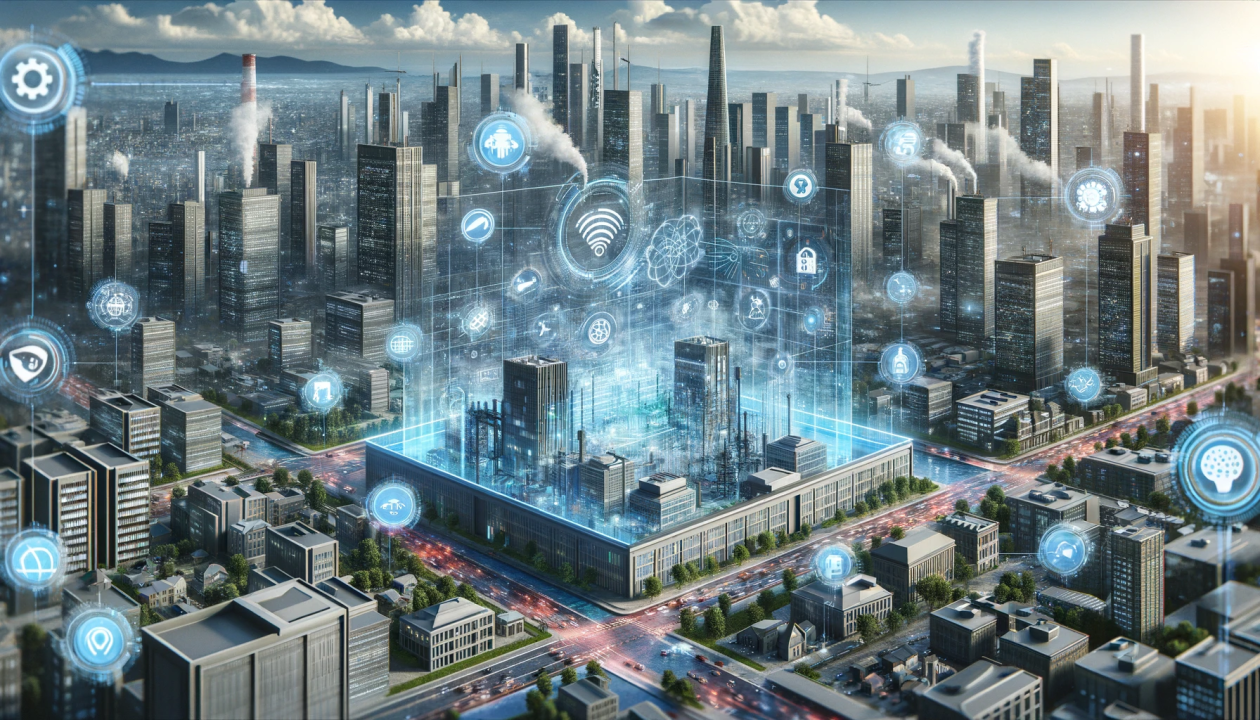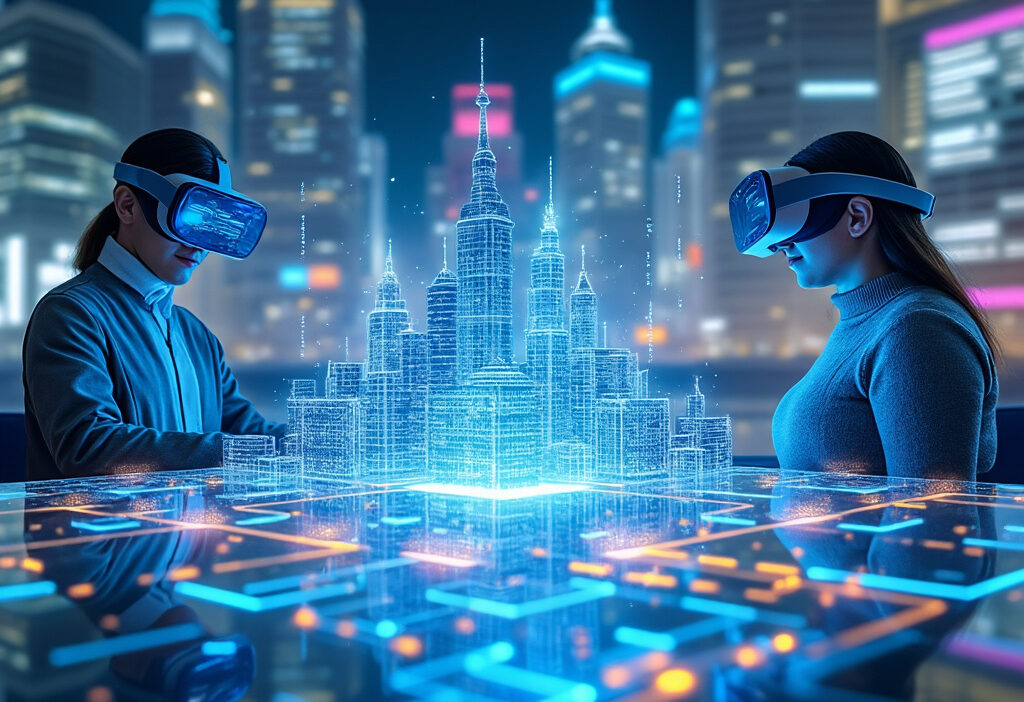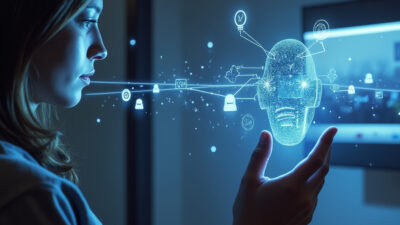Exploring the Convergence of Digital Twins and Extended Reality (XR)
The fusion of Digital Twins and Extended Reality (XR) is revolutionizing how we interact with and understand the digital and physical worlds. This article delves into their synergy, exploring how they enhance simulations, training, and real-time decision-making across industries. From manufacturing to healthcare, discover the transformative potential of these technologies when combined.
Understanding Digital Twins
Digital twins are dynamic, real-time digital representations of physical systems, processes, or products that enable advanced simulation, analysis, and optimization. The concept traces its roots to NASA’s Apollo program, where engineers created mirrored systems to simulate spacecraft conditions and troubleshoot issues remotely. Today, digital twins have evolved far beyond aerospace, becoming integral to industries like manufacturing, healthcare, and smart cities.
At their core, digital twins rely on a continuous flow of data from sensors, IoT devices, and other sources to maintain an accurate virtual model. This bidirectional synchronization allows the digital twin to not only reflect the current state of its physical counterpart but also predict future behavior using AI and machine learning. For instance, in manufacturing, digital twins simulate production lines to identify bottlenecks or predict equipment failures before they occur, drastically reducing downtime.
The power of digital twins lies in their ability to bridge the physical and digital worlds. They enable scenario testing in a risk-free environment—whether optimizing energy consumption in a smart building or refining autonomous vehicle algorithms. By integrating with Extended Reality (XR), digital twins unlock even greater potential, allowing engineers and operators to interact with these simulations in immersive, spatially aware environments. This convergence, which we’ll explore further in the next chapter, is redefining how industries visualize, analyze, and interact with complex systems.
As digital twins become more sophisticated, their role expands beyond monitoring into proactive decision-making, shaping the future of predictive maintenance, personalized medicine, and sustainable urban planning. Their synergy with emerging technologies like XR underscores their transformative impact across sectors.
The Spectrum of Extended Reality
Extended Reality (XR) represents a spectrum of immersive technologies that blend the physical and digital worlds, offering transformative ways to interact with data and environments. At its core, XR encompasses three primary modalities: Augmented Reality (AR), Mixed Reality (MR), and Virtual Reality (VR). Each of these technologies serves distinct purposes while sharing the common goal of enhancing human perception and interaction.
Augmented Reality (AR) overlays digital information onto the real world, typically through smartphones or smart glasses. Industries like retail use AR for virtual try-ons, while healthcare leverages it for surgical guidance. Virtual Reality (VR), on the other hand, immerses users in entirely synthetic environments, often via headsets. VR is widely adopted in training simulations, such as flight simulators for pilots or hazardous scenario drills for emergency responders. Bridging the gap between AR and VR, Mixed Reality (MR) integrates interactive digital objects into the physical world, allowing for real-time manipulation. MR is particularly valuable in engineering and design, where professionals can interact with 3D models as if they were tangible.
The applications of XR extend far beyond entertainment. In education, XR enables immersive learning experiences, from virtual field trips to complex scientific visualizations. Manufacturing benefits from XR-powered remote assistance, where experts guide on-site technicians through repairs using AR annotations. Real estate leverages VR for virtual property tours, while urban planning uses MR to visualize infrastructure projects within existing cityscapes.
The potential of XR lies in its ability to create deeply immersive, interactive experiences that transcend traditional interfaces. As industries increasingly adopt XR, its convergence with technologies like Digital Twins—discussed in the previous chapter—opens new frontiers for simulation, collaboration, and decision-making, setting the stage for the next chapter’s exploration of their synergy.
The Synergy Between Digital Twins and XR
The synergy between Digital Twins and Extended Reality (XR) is transforming how industries visualize, interact with, and optimize complex systems. Digital Twins—virtual replicas of physical assets—provide real-time data and simulations, while XR technologies like AR, VR, and MR offer immersive interfaces to interact with these models. Together, they bridge the gap between digital and physical worlds, enabling deeper insights and more intuitive decision-making.
In manufacturing, this combination allows engineers to overlay real-time sensor data from a Digital Twin onto a physical machine using AR, highlighting potential failures or inefficiencies. For instance, technicians wearing AR headsets can see step-by-step maintenance instructions superimposed on equipment, reducing downtime. In VR, teams can collaboratively explore a Digital Twin of a factory layout before construction, testing workflows and identifying bottlenecks in a risk-free environment.
The energy sector leverages this synergy for remote monitoring of wind turbines or oil rigs. Operators use MR to interact with a Digital Twin, visualizing stress points or performance metrics in 3D, even from thousands of miles away. Similarly, in urban planning, city officials can walk through a VR replica of a smart city, simulating traffic flows or emergency responses based on live data from IoT sensors.
The healthcare industry also benefits, with surgeons practicing complex procedures on patient-specific Digital Twins in VR, improving precision and reducing risks. These integrations highlight how Digital Twins and XR amplify each other’s strengths—combining data-driven accuracy with immersive interaction—paving the way for smarter, more responsive industries.
Digital Twins in Manufacturing and Beyond
Digital twins are revolutionizing manufacturing by creating virtual replicas of physical assets, processes, and systems. In lean manufacturing, digital twins enable real-time monitoring and optimization of production lines, reducing waste and improving efficiency. By simulating different scenarios, manufacturers can identify bottlenecks, test process changes, and predict outcomes without disrupting actual operations. For example, automotive companies use digital twins to model assembly lines, ensuring seamless integration of robotics and human workers while minimizing downtime.
Preventive maintenance is another critical application. Digital twins collect data from IoT sensors embedded in machinery, analyzing performance trends to predict failures before they occur. This proactive approach reduces unplanned downtime and extends equipment lifespan. Industries like aerospace leverage this technology to monitor jet engines, scheduling maintenance only when necessary, thereby cutting costs and enhancing safety.
Beyond manufacturing, digital twins are transforming healthcare. Hospitals use them to simulate patient flows, optimizing bed allocation and staff scheduling. Surgeons even practice complex procedures on digital replicas of organs, improving precision and reducing risks. In urban planning, cities employ digital twins to model traffic patterns, energy consumption, and disaster responses. For instance, Singapore’s Virtual Singapore project creates a dynamic 3D model of the city, helping planners test infrastructure changes and improve sustainability.
The convergence of digital twins with XR amplifies these benefits, as explored in the previous chapter, by enabling immersive interaction with virtual models. Meanwhile, the next chapter will delve into how XR alone is reshaping training and education, further illustrating the symbiotic relationship between these technologies in driving innovation across industries.
XR’s Role in Training and Education
XR technologies are revolutionizing training and education by creating immersive, interactive environments that bridge the gap between theory and practice. Unlike traditional methods, which often rely on passive learning, XR—encompassing virtual reality (VR), augmented reality (AR), and mixed reality (MR)—enables hands-on experiences in risk-free, highly controlled settings. For instance, medical students can perform virtual surgeries, allowing them to practice complex procedures repeatedly without endangering patients. Similarly, industrial trainees can operate heavy machinery in a simulated environment, reducing the risks and costs associated with real-world training.
One of the most transformative aspects of XR in education is its ability to scale experiential learning. In fields like aviation, pilots train in hyper-realistic flight simulators that replicate real-world conditions, from turbulence to system failures. These simulations are not just visual; they incorporate haptic feedback and spatial audio to deepen immersion. Meanwhile, in corporate settings, AR overlays can guide technicians through equipment repairs by superimposing step-by-step instructions onto physical machinery, reducing downtime and human error.
XR also democratizes access to specialized training. Remote learners can participate in collaborative virtual classrooms, breaking geographical barriers. For example, engineering students across the globe can collectively assemble a virtual engine, manipulating individual components in real time. This collaborative aspect extends to soft skills training, where VR scenarios simulate high-pressure negotiations or customer interactions, providing immediate feedback through AI-driven analytics.
The integration of XR with digital twins further enhances its potential. While digital twins replicate physical systems for monitoring and optimization, XR brings these models to life, allowing users to interact with them in real time. This synergy is particularly powerful in fields like urban planning, where stakeholders can explore a digital twin of a city through VR, testing infrastructure changes before implementation. As XR hardware becomes more affordable and software more sophisticated, its role in education and training will only expand, reshaping how skills are acquired and mastered.
Technological Foundations and Innovations
The convergence of Digital Twins and Extended Reality (XR) is powered by a suite of cutting-edge technologies that enable real-time, high-fidelity simulations and immersive interactions. At the core of this synergy are advancements in 5G networks, which provide the ultra-low latency and high bandwidth required for seamless data exchange between physical and virtual environments. Without 5G, the dynamic synchronization of digital twins with their real-world counterparts—or the streaming of complex XR content—would be impractical.
Edge computing further enhances this ecosystem by decentralizing data processing, reducing reliance on distant cloud servers. This is critical for applications like industrial digital twins, where split-second decisions based on sensor data can prevent equipment failures. Similarly, XR experiences benefit from edge computing by minimizing motion-to-photon latency, ensuring smoother and more responsive virtual environments.
Artificial Intelligence (AI) acts as the brain behind both technologies. Machine learning algorithms analyze vast datasets from IoT sensors to predict system behaviors in digital twins, while AI-driven computer vision enables XR devices to understand and interact with the physical world. Generative AI is also pushing boundaries, automating the creation of 3D models for XR or simulating countless “what-if” scenarios for digital twins.
Together, these innovations are reshaping industries. For example, in smart manufacturing, digital twins paired with XR allow engineers to visualize and troubleshoot production lines in real time, while AI optimizes workflows. The integration of these technologies isn’t just incremental—it’s transformative, laying the groundwork for a future where virtual and physical realms are indistinguishable. However, as the next chapter will explore, this potential comes with significant challenges.
Challenges and Limitations
Despite the transformative potential of Digital Twins and Extended Reality (XR), their widespread adoption faces significant challenges. Technical limitations remain a primary barrier. For Digital Twins, the sheer volume of real-time data required to maintain accurate virtual replicas strains existing infrastructure, even with advancements in 5G and edge computing. Latency issues can disrupt synchronization between physical and digital counterparts, particularly in mission-critical applications like manufacturing or healthcare. Similarly, XR struggles with hardware constraints—high-resolution displays, precise motion tracking, and low-latency rendering demand substantial processing power, often leading to bulky, expensive devices that hinder mass adoption.
Data privacy and security are equally pressing concerns. Digital Twins rely on continuous data feeds from IoT sensors, raising risks of unauthorized access or cyberattacks that could compromise sensitive operational data. In XR, user biometric data—such as eye tracking or spatial movements—must be safeguarded to prevent misuse, especially in enterprise or healthcare settings. Regulatory frameworks lag behind these technologies, leaving gaps in accountability and compliance.
Ethical dilemmas also emerge. The hyper-realistic simulations enabled by Digital Twins and XR blur the line between virtual and physical, potentially leading to misuse in areas like deepfake creation or manipulative training environments. Additionally, the digital divide could widen as these technologies demand high-end infrastructure, excluding smaller businesses or developing regions from benefiting equally.
Lastly, interoperability remains a hurdle. Fragmented standards across platforms and industries complicate integration, forcing organizations to invest heavily in custom solutions. Without cohesive ecosystems, the scalability of Digital Twins and XR will remain constrained, delaying their full potential despite the innovations discussed earlier. These challenges must be addressed to pave the way for the future trends explored next.
Future Prospects and Emerging Trends
The convergence of Digital Twins and Extended Reality (XR) is poised to redefine industries and everyday experiences, driven by rapid advancements in AI, IoT, and immersive technologies. As these tools mature, their integration will unlock unprecedented levels of interactivity, predictive analytics, and real-time decision-making.
One emerging trend is the rise of hyper-realistic simulations, where Digital Twins become dynamic, living models that evolve with their physical counterparts. XR will enhance this by enabling users to interact with these twins in fully immersive environments, blurring the lines between virtual and physical worlds. For instance, engineers could troubleshoot a malfunctioning factory line by stepping into a 1:1 XR replica, guided by AI-driven diagnostics from the Digital Twin.
Another key development is the democratization of these technologies. Cloud-based platforms and edge computing will make Digital Twins and XR more accessible to smaller enterprises, reducing barriers to adoption. Meanwhile, advancements in haptic feedback and neural interfaces will deepen immersion, allowing for tactile interactions with virtual twins—revolutionizing fields like remote surgery or precision training.
Ethical and societal implications will also shape their evolution. As Digital Twins and XR become more pervasive, questions around data ownership, virtual identity, and digital permanence will arise. However, proactive governance and standardized frameworks could mitigate risks while fostering innovation.
Looking ahead, the synergy between these technologies will extend beyond industrial applications into smart cities, personalized healthcare, and even entertainment. The next decade will likely see Digital Twins and XR becoming as ubiquitous as smartphones, seamlessly integrated into workflows and daily life—ushering in an era where the physical and digital worlds are indistinguishable.
Case Studies and Real-World Applications
The convergence of Digital Twins and Extended Reality (XR) is already transforming industries, with real-world applications demonstrating their combined potential. In manufacturing, companies like Siemens leverage digital twins paired with XR to optimize production lines. Workers use AR headsets to overlay real-time data from digital twins onto physical machinery, enabling predictive maintenance and reducing downtime by up to 30%. Similarly, BMW employs VR simulations of digital twins to train assembly line workers, cutting training time by half while improving accuracy.
In healthcare, the integration of Digital Twins and XR is revolutionizing patient care. Surgeons at Mayo Clinic use AR to visualize patient-specific digital twins during complex procedures, enhancing precision and reducing risks. Meanwhile, Philips combines XR with digital twins of hospital layouts to streamline workflows, improving operational efficiency by 20%.
The construction sector also benefits from this synergy. Autodesk and Microsoft collaborate on Hololens-enabled digital twins, allowing architects and engineers to walk through virtual building models before construction begins. This approach has slashed design errors by 40% and accelerated project timelines.
Retail is another frontier, with IKEA using AR to let customers place digital twins of furniture in their homes via smartphones, boosting sales conversions by 15%. Meanwhile, logistics firms like DHL deploy XR interfaces linked to digital twins of warehouses, optimizing inventory management and reducing picking errors.
These case studies underscore how Digital Twins and XR are not just theoretical concepts but practical tools driving efficiency, safety, and innovation across industries. Their combined adoption is setting new benchmarks for operational excellence.
Getting Started with Digital Twins and XR
Getting started with Digital Twins and Extended Reality (XR) requires a strategic approach, whether you’re a business leader or an individual exploring these technologies. The first step is identifying clear use cases that align with your goals. For Digital Twins, this could involve asset monitoring, predictive maintenance, or process optimization. For XR, applications range from immersive training to virtual prototyping.
To build a Digital Twin, you’ll need IoT sensors for real-time data collection, a robust data platform like Microsoft Azure Digital Twins or IBM Watson IoT, and visualization tools such as Unity or Unreal Engine. Start small—focus on a single asset or process before scaling. Best practices include ensuring data accuracy, integrating with existing systems, and continuously refining the twin based on feedback.
For XR, choosing the right hardware is critical. Meta Quest and Microsoft HoloLens are popular for AR/VR, while WebXR offers browser-based accessibility. Development platforms like Unity, Unreal Engine, or Amazon Sumerian simplify creating immersive experiences. Prioritize user experience—ensure interactions are intuitive and latency is minimized. Collaboration tools like NVIDIA Omniverse can bridge gaps between teams working on XR and Digital Twins.
Training is essential. Invest in upskilling teams on 3D modeling, IoT, and XR development. Leverage online courses from Coursera or Udemy, and consider partnering with experts for pilot projects. Finally, measure success through KPIs like reduced downtime (for Digital Twins) or improved training outcomes (for XR). By starting with a focused approach and scaling strategically, businesses can unlock the transformative potential of these converging technologies.

Conclusions
The integration of Digital Twins and Extended Reality (XR) marks a significant leap forward in how we simulate, interact with, and optimize the world around us. As these technologies continue to mature and converge, they promise to unlock unprecedented opportunities for innovation, efficiency, and immersive experiences across all sectors of society.



